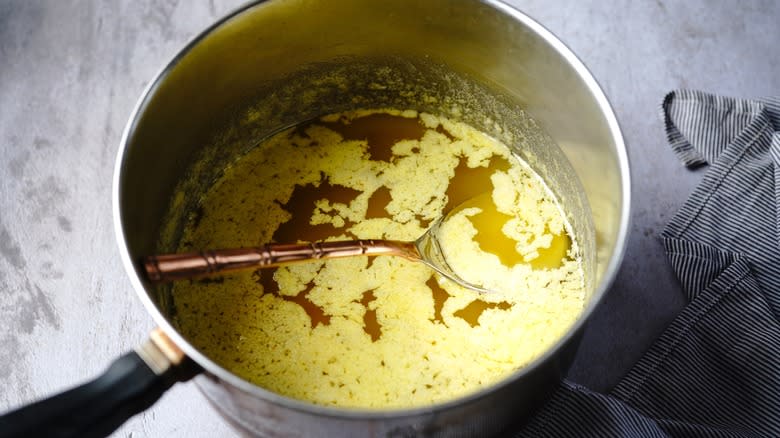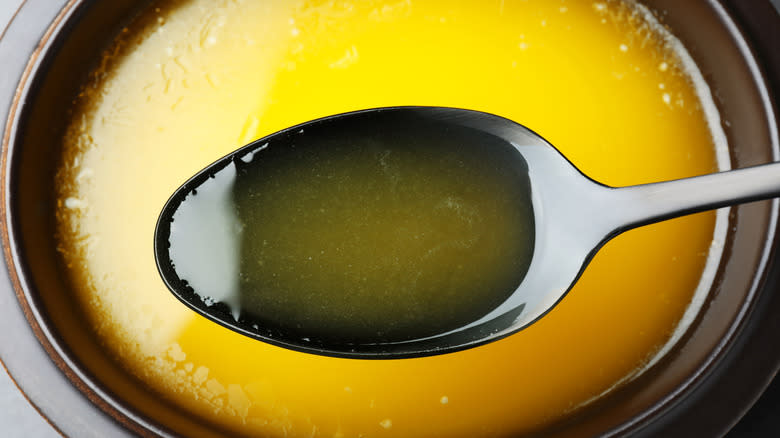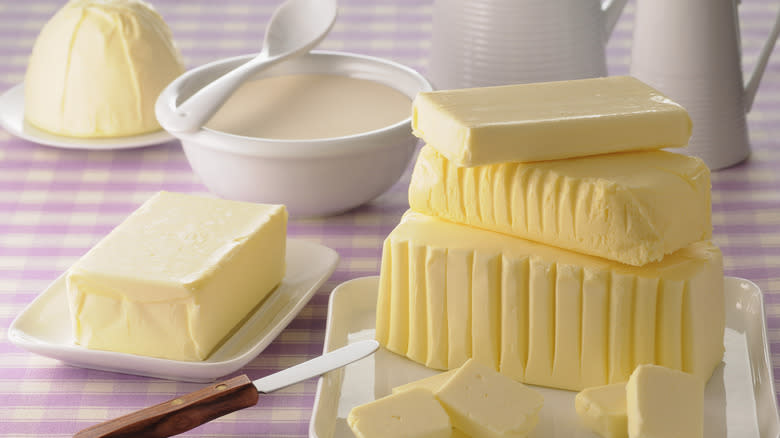The Heat Mistake You Need To Avoid When Clarifying Butter

From adding richness to a sauce to frying in that golden liquid, clarified butter can be the flavor gift to a myriad of recipes. While that luscious liquid has people swooning, making clarified butter requires a watchful eye. Although a watch pot never boils, a slow, low rise in temperature ensures the final product will be pristine.
While some cooks might look at butter and think that it is a stick of fatty deliciousness, that churned milk product does contain water. Water content is part of butter's essential makeup, though different types contain varying percentages. Without it out, baked goods would have very different textures.
When clarifying butter, it is essential to allow the solid butter to melt gently. As it changes states, the water slowly separates, and some evaporates, from the butterfat. Through the process, three layers appear. The water and milk solids fall to the bottom of the pot, the foam rises to the top to be skimmed away, and the center portion becomes the sought-after clarified butter.
The process should not be rushed. By employing a low, slow-cooking method, the layers are less likely to commingle. Even though clarified butter can be strained through cheesecloth or a chinois, avoiding an extra step can be beneficial. The next time that a recipe calls for clarifying butter, add a few extra minutes to the schedule. The slow simmer method can produce a better final result.
Read more: French Cooking Tricks You Need In Your Life
Skip The Urge To Stir Clarified Butter

While the low, slow-heating method transforms a stick of butter into that golden liquid, another key cooking technique is imperative when making clarified butter. Although some cooks feel the need to flip, fuss, and otherwise touch food during the cooking process, it should be all hands-off during this task. Stirring the pot when making clarified butter is a definite don't.
From the errant pop to the occasional splatter, the process of water and milkfat separating from the butterfat can get the cook's attention. With a spoon in hand, the action on the stove makes it seem beneficial to swirl that utensil around the pan. Unfortunately, stirring causes the layers to mix which defeats the process of separating the layers.
To remove the top layer of foam, it is imperative to carefully skim that portion without unsettling the other layers. If the various parts are displaced, no one has to start over from scratch. Simply strain the liquid gold and hope that no milk solids corrupt the final product.
With that glistening, flavorful ingredient in hand, the clarified butter can be used in a multitude of ways. From frying to sautéing to even being the key ingredient in a Hollandaise sauce, there are a plethora of uses. Since the clarified butter can be stored in an airtight container for up to six months, it might be beneficial to make a larger serving. Having a flavorful, versatile ingredient at the ready can be a cook's secret weapon.
Does The Type Of Butter Matter When Making Clarified Butter?

While people can appreciate the differences between salted, unsalted, or vegan butter, not all sticks are created equal. For example, European butter, often touted for its use in baking, is different from a regular stick of Land O Lakes. Generally, European-style butter has more butterfat and less water content. Since clarified butter separates the water and milk fat, does it make sense to use non-American butter as the starting point?
The smaller water percentage in European butter is not just about layer separation in the execution. Given that European-style kinds of butter can have richer, more robust concentrated notes, it can make the resulting clarified butter more flavorful.
In addition, cooks should proceed with caution when using salted butter. While it is possible to use this type of ingredient, a less salted or slightly salted option can be preferred so that there is better control over the sodium levels in a recipe.
As is true with any recipe, thoughtful ingredient choices will impact the final dish. Whether it is a European-style butter, salted butter, or another option on the shelf, any cook needs to understand how the ingredients' flavors will meld together. It might not be rocket science, but appreciating flavor balance does take attention to detail.
Read the original article on Daily Meal.

 Yahoo Finance
Yahoo Finance 